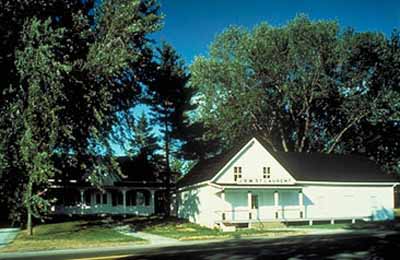Louis S. St. Laurent National Historic Site of Canada
Compton, Quebec

General view
© Parks Canada Agency/ Agence Parcs Canada
Address :
6790 Louis-S.-St-Laurent Road, Compton, Quebec
Recognition Statute:
Historic Sites and Monuments Act (R.S.C., 1985, c. H-4)
Designation Date:
1973-11-15
Dates:
-
1839 to 1908
(Construction)
-
1866 to 1866
(Significant)
-
1885 to 1900
(Significant)
-
1903 to 1908
(Significant)
-
1974 to 1974
(Acquired)
Event, Person, Organization:
-
Louis S. St-Laurent
(Person)
Other Name(s):
-
Louis S. St. Laurent
(Designation Name)
Research Report Number:
1974-SUC
DFRP Number:
06043 00
Plaque(s)
Existing plaque: 6790 Louis-S.-St-Laurent Road, Compton, Quebec
Saint-Laurent was born in Compton. Called to the bar in 1905, he acted for many large companies, and represented the federal government before the Privy Council in London. He entered politics as a minister of justice in 1941, served as secretary of state for external affairs (1946 - 48), and was prime minister from 1948 to 1957. A fervent advocate of national unity, he played a key role in the legal and constitutional development of Canada. He was one of the architects of the new Commonwealth, a signer of the United Nations Charter, and a promoter of NATO. He died in Québec City.
Description of Historic Place
Located in the Québec Eastern Townships, in the heart of the village of Compton, Louis S. St. Laurent National Historic Site of Canada consist of a house, a general store and its warehouse, a small shed and a shelter associated with Louis S. St. Laurent, former Prime Minister of Canada, all within a landscape design that retains traces of its evolution. More recently, two structures have been built, one recalling a former stable in its location and massing.
Heritage Value
Louis S. St. Laurent National Historic Site of Canada was designated because: the property commemorates Louis S. St. Laurent, Prime Minister of Canada; the property commemorates the social history of the Eastern Townships.
The heritage value of Louis S. St. Laurent National Historic Site of Canada resides in the features of its cultural landscape associated with the life of Louis S. St. Laurent (1882-1973), and in the general manner in which its cultural landscape depicts village life in the Eastern Townships over one century.
Louis S. St. Laurent was born on this property; he inherited a share of it in 1933, and retained ownership until 1971. The historic site consists of three lots assembled by his parents in 1881 and 1908, and contains four surviving structures from this period. Two buildings, a house and a general store, were acquired from previous owners by the St. Laurents in 1881, and eventually expanded. Two structures were added by the family: a small shed (1885 - 1900) and a weigh scale shelter (1936). In addition, there are archaeological remnants of buildings from the St. Laurent period, and two buildings constructed at a later date. Parks Canada assumed management in 1975.
Sources: HSMBC Minutes, 1973, 1974, 1976; Commemorative Integrity Statement, 2001.
Character-Defining Elements
Key features contributing to the heritage value of this site include:
the evolved complex and the inter-relationship of components including buildings, outbuildings, remains and landscape features, the functional layout of the property with the store adjacent to the street and the house in a recessed setting to the rear, the location on a village main street.
The house its L-shaped footprint with main block and rear extension under gable roofs, the symmetrically organized façade with central doorway, dormer and balcony, and porch, the balanced forms of windows and shutters on the façade, the wooden construction and finishing material, the restrained detailing including porch brackets, balcony and stair railings, prominent door with arched lights, its found interior layout and central hall plan, found interior detailing, materials and finishes, furnishings of the house that date from the Louis S. St. Laurent era.
The general store its L-shaped massing with a pitched end-gabled roofs, the symmetrical placement of doors and windows in both parts of the building, the functional design features including porch, central door, large display windows, central stove and disposition of space, its wood construction materials, the original interior forms, finishes, furnishings and craftsmanship.
The shed the simple, square massing under a pitched roof, its central door, its wood construction material, its siting on the rear lot line of the original property.
The weigh scale shelter its square under a pitched roof, its central door and trellised walls, its wood construction materials, its siting at the rear of the property.
Archaeological remains footprints of buildings from the St. Laurent period, including a stable (pre-1881), a woodshed (post-1881), and a combined store-residence (acquired in 1908).
Landscape features the broad lawns, mature trees, the sidewalks and pathways between and among the buildings, the broad walkway between the front door of the store and the street, viewscapes from the store up and down the main street.